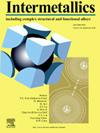具有增强耐磨性和耐腐蚀性的铁铁基大块金属玻璃
IF 4.8
2区 材料科学
Q2 CHEMISTRY, PHYSICAL
引用次数: 0
摘要
海水中含有高浓度的Cl -离子,长期暴露在海水中会导致船体严重腐蚀和磨损,从而增加维护和运行成本。在这项工作中,我们开发了一系列Cr含量超过30at .%的fecr基大块金属玻璃。值得注意的是,当Cr含量达到30at时。%,合金具有优异的综合性能,玻璃化转变温度高达904 K,硬度高达1429 HV。这些增强是由于Cr-C和Cr-B键的含量增加。在所研究的组合物中,Fe37Cr30W10C13.5B7.5Y2合金表现出优异的耐磨性,磨损率低至6.33 × 10−6 mm3 N−1 m−1。然而,进一步提高Cr含量至37at。磨耗率为9.17 × 10−6 mm3 N−1 m−1。这可能是由于压痕韧性的降低,这增加了脆性,促进了疲劳磨损。Fe37Cr30W10C13.5B7.5Y2合金在3.5 wt% NaCl溶液中具有良好的耐腐蚀性,自腐蚀电流密度为2.25 × 10−6 a /cm2。然而,过量的铬含量会破坏钝化层的稳定,导致过早的点蚀。这种降解是由于钝化过程中Cr3+/Cr6+比值的急剧下降和阳离子空位的增加,两者共同降低了耐蚀性。本文章由计算机程序翻译,如有差异,请以英文原文为准。
FeCr-based bulk metallic glasses with enhanced wear and corrosion resistance
Seawater contains a high concentration of Cl− ions, and prolonged exposure can lead to severe corrosion and wear of ship hulls, thereby increasing maintenance and operational costs. In this work, we developed a series of FeCr-based bulk metallic glasses with Cr content exceeding 30 at.%. Notably, when the Cr content reaches 30 at.%, the alloy exhibits excellent comprehensive performance, including a high glass transition temperature of 904 K and a hardness of 1429 HV. These enhancements are attributed to the increased contents of Cr-C and Cr-B bonds. Among the compositions studied, the Fe37Cr30W10C13.5B7.5Y2 alloy exhibits superior wear resistance, with a wear rate as low as 6.33 × 10−6 mm3 N−1 m−1. However, further increasing the Cr content to 37 at.% results in a higher wear rate of 9.17 × 10−6 mm3 N−1 m−1. This might be due to the reduction in indentation toughness, which increases the brittleness and promotes fatigue wear. Moreover, the Fe37Cr30W10C13.5B7.5Y2 alloy shows good corrosion resistance in a 3.5 wt% NaCl solution, with a low self-corrosion current density of 2.25 × 10−6 A/cm2. Nevertheless, excessive Cr content destabilizes the passivation layer, leading to premature pitting corrosion. This degradation arises from a sharp decrease in the Cr3+/Cr6+ ratio during passivation and an increase in cation vacancies, which together reduce the corrosion resistance.
求助全文
通过发布文献求助,成功后即可免费获取论文全文。
去求助
来源期刊

Intermetallics
工程技术-材料科学:综合
CiteScore
7.80
自引率
9.10%
发文量
291
审稿时长
37 days
期刊介绍:
This journal is a platform for publishing innovative research and overviews for advancing our understanding of the structure, property, and functionality of complex metallic alloys, including intermetallics, metallic glasses, and high entropy alloys.
The journal reports the science and engineering of metallic materials in the following aspects:
Theories and experiments which address the relationship between property and structure in all length scales.
Physical modeling and numerical simulations which provide a comprehensive understanding of experimental observations.
Stimulated methodologies to characterize the structure and chemistry of materials that correlate the properties.
Technological applications resulting from the understanding of property-structure relationship in materials.
Novel and cutting-edge results warranting rapid communication.
The journal also publishes special issues on selected topics and overviews by invitation only.
 求助内容:
求助内容: 应助结果提醒方式:
应助结果提醒方式:


